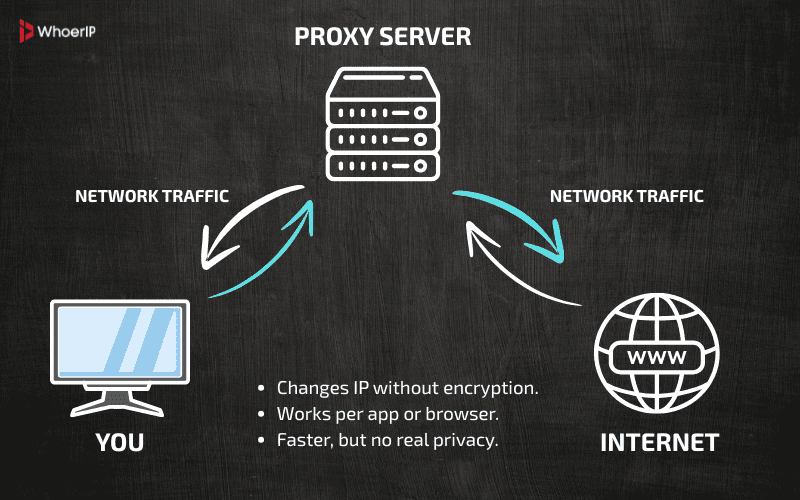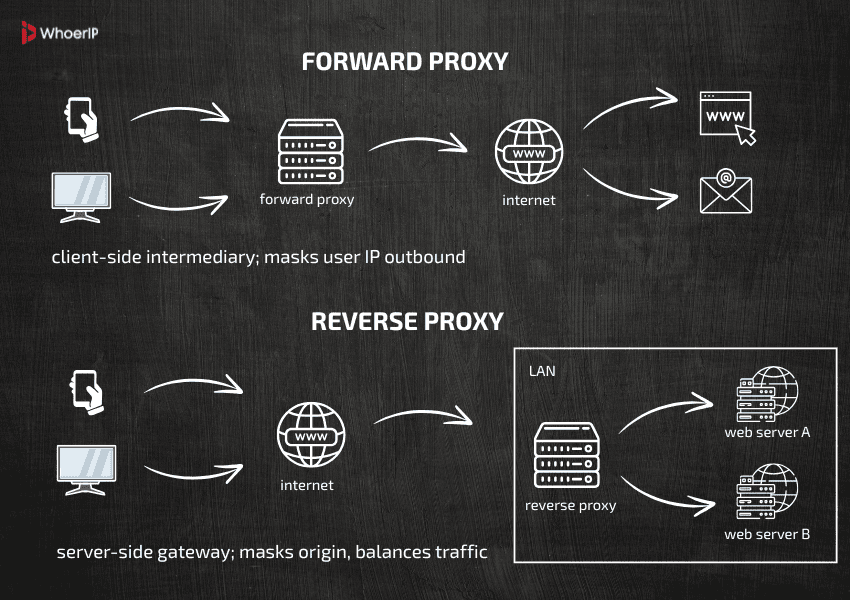Proxies can be confusing because the word “proxy” describes many different behaviors. This guide cuts through the noise by organizing all types of proxies the same way a network engineer or anti-fraud analyst would: by level of anonymity, IP source, traffic flow, protocol, rotation policy, and price/exclusivity. You’ll also get a simple decision flow so you can pick the right option without second-guessing—and a safe way to test your setup on whoerip.com.
What is a proxy server, in one sentence?
A proxy is an intermediary server that forwards your requests to the internet and returns responses, masking your device’s direct connection with its own IP address.

Put another way, when you use a proxy your destination site sees the proxy’s IP—not yours. Depending on the type, a proxy can add or strip headers, cache content, pool many users behind one IP, or even rotate IPs per request. These differences are exactly why “types” matter.
If you only need to see your current IP, DNS, and leak status, run a quick check on our free IP lookup tool. It reports IP, ASN, DNS/WebRTC leaks, proxy/VPN flags, browser fingerprints, and gives a privacy score to spot weak points fast.
Pro tip: After you connect any proxy, open whoerip.com in that same browser/app to confirm the IP really changed and that DNS/WebRTC aren’t leaking. If they are, fix your settings before logging into any accounts.
Based on the level of anonymity
Straight answer: Proxies by anonymity are typically grouped as transparent, anonymous, and elite (high-anonymity), defined by how much client information they reveal to the destination.
- Transparent proxies forward your request and explicitly identify themselves as proxies—often passing your original IP in headers like
X-Forwarded-For. These are common in corporate or ISP settings for caching and policy. They’re not for privacy because sites can see both “proxy” and “you.” - Anonymous proxies hide your original IP but may still add headers that say “I am a proxy.” They improve privacy but don’t try to conceal the existence of a proxy.
- Elite (high-anonymity) proxies hide your IP and avoid proxy-revealing headers, aiming to look like a normal client. In practice, sites still use advanced signals (timing, TLS fingerprint, DNS behavior) to infer proxy use, but elite setups minimize obvious giveaways.
For alternatives and layered tactics, see how to hide your IP address without a VPN, then pair a well-configured proxy with HTTPS, cookie isolation, and steady session policies.
Based on IP address source
Straight answer: Proxies are sourced from datacenter, residential, ISP (static residential), or mobile IP ranges, each with trade-offs in trust, speed, and cost.
- Datacenter proxies come from hosting providers. They’re fast, abundant, and affordable, but many sites treat hosting ASNs as risky. Great for speed-sensitive tasks when detection risk is low.
- Residential proxies use IPs assigned to home users by consumer ISPs. Traffic “appears” to originate from normal households, making it harder to block—often at the cost of higher latency and price.
- ISP (static residential) proxies are real ISP-issued IPs leased for proxy use—giving you residential reputation with static stability. They sit between datacenter and residential in cost and trust.
- Mobile proxies route through 3G/4G/5G carrier networks using CGNAT. Many users share a single IP at any moment, which can dilute per-user signals and sometimes bypass strict filters, but speeds and costs vary.
IP reputation isn’t just about the ASN (hosting vs ISP). whoerip.com checks if the IP is on known blacklists, whether it looks like a proxy/VPN, and whether your DNS leaks point somewhere unexpected—good signals for “trustworthiness” beyond the label.
Pro tip: If your workflow requires stable sessions (logins, carts, or long-running tasks), consider ISP/static residential. If you need scale and speed at lower cost, datacenter can be ideal—just expect stricter rate limits on sensitive sites.
Curious what a residential proxy is, how it differs from datacenter/mobile, and when to use it? Our quick guide — What is a Residential Proxy — explains static vs rotating IPs, sticky sessions, and a simple whoerip.com leak check (IP/ASN, DNS, WebRTC) to stay undetected.
| Metric | Data Center Proxies | Residential Proxies |
|---|---|---|
| Ideal targets/users | Less-complex sites benefiting from fast static IPs | Sophisticated sites that benefit from IP rotation |
| Rotation / Static | Static | Rotating |
| Source of IPs | IPs hosted in data centers | IPs from real users’ computers & smart devices |
| Speed | High | Medium |
| Advantages | Keep IPs long-term; high speeds; IPs don’t change | IPs from any location; very hard to block; better for tough sites |
| Anonymity | High | Very high |
| Block risk | Detectable | Virtually undetectable |
| Best for | Web scrapers, social media monitoring, scalper bots, managing multiple accounts | Collecting identity-sensitive public data, large-scale data, review monitoring, ad verification |
| Cost | Low | Medium–High |
Based on traffic flow
Forward proxies serve clients going out to the internet, while reverse proxies sit in front of servers to protect, cache, or load-balance incoming traffic.
- Forward proxy (what most people mean by “a proxy”) accepts your request and forwards it to the web. It can be per-app (browser proxy) or system-wide.
- Reverse proxy sits in front of web servers (think CDNs and load balancers). It’s not about hiding the client; it masks and protects the server, terminates TLS, caches content, performs WAF checks, and distributes load.

There are also transparent proxies used by organizations to enforce policies, cache proxies for speed, and gateway/NAT devices that share a public IP among many clients.
Pro tip: If your use case is content delivery, DDoS resistance, or private backend exposure, you’re looking for a reverse proxy pattern. If your goal is privacy, IP rotation, or data collection from public sites, you’re looking for a forward proxy.
Based on the connection protocol
Straight answer: Common client-facing proxy protocols are HTTP/HTTPS (HTTP CONNECT) and SOCKS (SOCKS4/SOCKS5), with SOCKS5 being the most flexible for arbitrary TCP traffic.
- HTTP/HTTPS proxies understand HTTP; they can read/modify headers, cache, and (with CONNECT) tunnel HTTPS. Because they “speak HTTP,” they’re ideal for web-only traffic and header-level controls.
- SOCKS4/SOCKS5 proxies are lower-level, forwarding arbitrary TCP (and UDP in SOCKS5). SOCKS doesn’t add HTTP headers, making it agnostic to application protocols—great for apps, crawlers, or tools that aren’t just web browsers.
- Additional patterns include PAC/WPAD configuration (automatic proxy settings), and specialized transports like TLS/CONNECT chaining or SSH tunnels that behave “proxy-like” for secure forwarding. Some censorship-resistant systems (e.g., obfuscation layers) also provide proxy semantics but are beyond the scope of normal web privacy tasks.
If a site blocks “proxy-ish” headers, use SOCKS5. If you need header rewrites, allow-lists, or per-domain rules, use HTTP with CONNECT and fine-grained policies.
Pro tip: Always test DNS behavior per protocol. A browser using an HTTP proxy might still leak DNS locally if not configured to resolve through the proxy. Our WebRTC and DNS tests on whoerip.com make these leaks obvious.
Based on rotation or stability
Straight answer: Rotation policies are static (one IP), sticky (session-based), or rotating (per request/time), chosen for session longevity vs. detection avoidance.
- Static proxies give you the same IP each time. Great for account logins or geofenced streaming when stability matters, but repetitive IP behavior can trigger rate limits.
- Sticky or session proxies pin you to an IP for a set duration (e.g., 10–30 minutes) before rotating. This balances continuity with some churn.
- Rotating or backconnect proxies swap IPs frequently—per request or per time slice—spreading risk and avoiding naive blocks. They can hurt flows that need cookies and long-lived sessions.
Pro tip: If you keep carts, dashboards, or checkout flows alive, use sticky/static. For scraping public, unauthenticated pages at scale, use rotating. When in doubt, start sticky, measure, then tune rotation.
By Price and Exclusivity
Pricing and exclusivity buckets are free/public, shared, semi-dedicated, and dedicated/private, with cost generally tracking exclusivity and quality.
- Free/public proxies are unreliable and risky; many log traffic, inject ads, or MITM content. They’re frequently blocked, slow, and unsuitable for anything account-based or sensitive.
- Shared proxies give multiple customers the same IP pool. They’re affordable and fine for low-risk tasks, but neighbors’ behavior can taint reputation or trigger blocks.
- Semi-dedicated (low-share) limits each IP to a small number of customers, improving stability and reputation while keeping price below true dedicated.
- Dedicated/private assigns IPs to a single customer. It’s the priciest option but best for long-term projects, brand protection, and stable account work.
“Exclusive” is sometimes advertised loosely. Clarify whether exclusivity applies to an IP, a subnet, or a city pool—and whether it’s time-bound.
Pro tip: If any part of your work touches monetized accounts, customer data, or compliance, skip free proxies entirely. Verify logging policies and jurisdiction, and run a quick whoerip.com fingerprint check to ensure nothing leaks.
Free proxies are convenient but risky—often slow, crowded, and prone to logging or breakage. Use only for low-stakes checks; read our Free Web Proxy Online overview and always verify IP/ASN, DNS, and WebRTC on whoerip.com.
Enterprise & maximum reliability
- Nodemaven — huge pools, high success rates, global coverage, dedicated managers; built for mission-critical workloads.
- Bright Data — full data-collection platform with strong compliance and auditing; ideal when governance matters.
- Decodo (ex Smartproxy) — near-enterprise stability and support at a friendlier price.
Choose when: you need strict SLAs, scale, and 24/7 support.
Types of Proxies: Quick Comparison Table (At a Glance)
| Dimension | Main options | Strengths | Trade-offs | Best for |
|---|---|---|---|---|
| Anonymity | Transparent / Anonymous / Elite | Control, privacy tiers | Transparent exposes you; elite costs | Corporate caching, general privacy, stricter sites |
| IP Source | Datacenter / Residential / ISP / Mobile | Speed vs trust spectrum | Price, latency, availability | Speedy tasks, harder sites, static sessions |
| Traffic Flow | Forward / Reverse | Client privacy vs server protection | Different goals | Browsing & scraping vs app delivery & WAF |
| Protocol | HTTP(S) / SOCKS5 | Header control vs protocol agnostic | App support varies | Web automation vs mixed protocols |
| Rotation | Static / Sticky / Rotating | Session stability vs block avoidance | Wrong choice kills success | Logins & carts vs high-scale crawling |
| Exclusivity | Free / Shared / Semi / Dedicated | Cost control vs quality | Free = risk; dedicated = cost | Experiments vs production accounts |
The best proxy for your needs depends heavily on your intended use case, desired level of anonymity, budget, and performance requirements. For privacy and security, options like Signal or VPNs are often preferred, while different proxy types may suit specific tasks like web scraping or geo-restricted content access.
We’ve also reviewed the top 20 proxy providers on the market in a single, constantly updated guide. It ranks each service by reliability, success rate, IP pool size and diversity, rotation controls, pricing per GB, support quality, and trial/refund policies—plus includes side-by-side comparison tables and use-case recommendations (accounts, large-scale scraping, mobile, geo access, and more).
Which one should you use? A simple decision framework
Choose by task: pick SOCKS5 + ISP/static residential sticky for accounts, HTTP(S) rotating residential for broad scraping, datacenter static for speed on non-sensitive sites, and mobile for mobile-only checks or strict filters.
Use this quick mapping:
- Logging into personal or business accounts (marketplaces, social dashboards, vendor portals): SOCKS5 or HTTP(S) with ISP/static residential, sticky or static rotation, dedicated or semi-dedicated exclusivity.
- Unauthenticated public scraping at scale (price monitoring, news aggregation): HTTP(S) rotating residential; consider datacenter for speed if the target is tolerant. Use short sessions.
- Ad verification & localized QA: Residential or ISP/static, city-specific, sticky sessions.
- Mobile-specific rendering or app store checks: Mobile proxies, sticky sessions, limited concurrency.
- Media streaming or geo-restricted content you have rights to view: ISP/static residential, static IPs in the correct region.
- Pentesting lab / learning network basics: Datacenter shared or dedicated, static, low cost.
Types of Proxies in Action: Practical Examples
Match the proxy to the risk and friction of your target—high-friction sites want trusted IPs and stable sessions; low-friction tasks tolerate cheaper, faster options.
- E-commerce account management: Elite anonymity + ISP/static residential, sticky 30-minute sessions, SOCKS5 for wider app support.
- News aggregation: Datacenter rotating can work; if blocked, switch to rotating residential HTTP(S) with a constrained rate.
- Brand protection for localized SERPs: Residential/ISP, city-aligned, static or sticky; validate DNS is local.
- Mobile ad placements: Mobile, sticky, throttle concurrency.
- Internal app behind reverse proxy: You don’t need a client proxy—use a reverse proxy with TLS termination and WAF.
Pro tip: “Elite” headers help, but the ASN and DNS path often decide your fate. A hosting ASN with mismatched DNS still screams “proxy” to many defenses. Always check both.
Security, compliance, and ethics
Use proxies only for lawful, authorized purposes; respect terms of service, robots.txt where applicable, and regional data laws.
Scraping public information isn’t a blank check—rate limits, access controls, and acceptable use policies matter. Avoid free/public proxies for anything sensitive; they may log or tamper with traffic. Keep compliance records for high-stakes work, and ensure you have a clear basis for geolocation changes (e.g., testing, research, or content you’re licensed to view). For practical workflows and safeguards, see Scraping Tools in Action.
Fast Fixes: Troubleshooting Quick Wins for Proxies
Most proxy failures come from DNS leaks, wrong protocol settings, or the wrong rotation policy for your workflow.
- Pages still show your real country: DNS leak—force DNS via proxy; retest WebRTC.
- Frequent logouts: You’re rotating too fast; move to sticky/static and keep cookies consistent.
- “Access denied” on first request: IP reputation; try ISP/static or mobile; reduce concurrency.
- Proxy “works” but downloads break: App doesn’t support HTTP proxy; switch to SOCKS5.
- Fingerprint mismatch: Align timezone, locale, OS, and fonts; verify on whoerip.com.
All Types of Proxies: summary and selection
If you remember one thing, remember this mapping—accounts → ISP/static SOCKS5 sticky, scale crawling → rotating residential HTTP(S), speedy tolerant tasks → datacenter static, mobile checks → mobile sticky.
That simple decision covers 90% of real-world needs. Everything else (elite headers, request pacing, header randomization) is an optimization you layer on top. And don’t skip the final step: test on whoerip.com to validate IP reputation, anonymity signals, and leak-free configuration before you do anything important.
For a vetted shortlist and side-by-side comparisons, see our ultimate review of the best proxy providers—it’s the most comprehensive guide online, designed to answer 100% of your questions with rankings, pricing, pool sizes, and use-case picks.
Frequently Asked Questions
What is the type of proxy?
Proxies are grouped by purpose, anonymity, origin, and mode. By purpose: forward (between client and internet) and reverse (in front of servers). By anonymity: transparent (shows your IP), anonymous (hides IP but reveals it’s a proxy), elite (hides both). By origin: residential (home-ISP IPs), datacenter (data-center IPs), sometimes mobile. By mode: static or rotating; shared or dedicated.
What is the best type of proxy?
There’s no single “best”—it depends on your task. For stealth and geo-unblocking, residential proxies work well because they look like real users. For high speed and lower cost, choose datacenter. For the toughest filters, mobile proxies help, but they’re pricier.
What are examples of a proxy?
A proxy is a go-between that relays requests and responses. Examples: web proxies for anonymous browsing, corporate proxies for filtering, forward proxies (e.g., Squid) that send client requests, reverse proxies (e.g., Nginx) that shield and load-balance servers, and CDN nodes, which are a kind of reverse proxy.
Is a VPN a type of proxy?
Yes. Both hide your IP. Difference: a VPN encrypts all traffic system-wide; a proxy usually works per protocol and may not encrypt.
How to identify proxy type?
Check system settings: Windows: Settings → Network & Internet → Proxy. macOS: System Settings → Network → your interface → Details → Proxies. Also run an online check (e.g., whoerip.com) to see protocol (HTTP/HTTPS/SOCKS), anonymity level, and leaks.
What is the most popular proxy?
Residential proxies are most used for “real user” traffic; datacenter for speed and price; mobile for the toughest blocks. Large providers often cited: Bright Data, Oxylabs, Decodo.
How to choose a proxy?
Define your goal (anonymity, speed, geo). Pick type: datacenter / residential / mobile. Evaluate anonymity, IP pool and geos, rotation/session control, speed/reliability, cost and usage policy. Test on a small scale first.
What is a static proxy?
A static (sticky) proxy gives you one fixed IP for your requests. Unlike rotating proxies, it keeps the same IP for a session—useful for logins, allowlists, and sites that dislike IP changes.
What is a common proxy?
The most common is a forward proxy. It sits between your device and the internet, hides your IP, and can add filtering, access control, and caching.
What is a proxy list?
A proxy list is a set of proxy IP:port entries. It lets you route traffic through different proxies to mask your IP, bypass geo-blocks, and handle tasks like scraping or multi-account management.
Does a proxy hide IP?
Yes. Websites see the proxy’s IP, not yours. Note: leaks (e.g., DNS/WebRTC) can still reveal you if misconfigured.
Which is safer, VPN or proxy?
VPN. It encrypts all traffic system-wide; most proxies don’t, and usually work per app/protocol.
Are there free proxy servers?
Yes, but they’re often slow, unreliable, and risky (logging or tampering). Use with caution.
What type of proxy is IPv4?
Not a special type—just a proxy that uses an IPv4 address to relay your traffic and mask your real IP.
Is NAT a type of proxy?
No. NAT translates addresses at the network layer; a proxy works at the application layer and can filter/cache.
Is DNS a proxy?
No. DNS is a naming system. A DNS proxy is a separate tool that forwards DNS queries on your behalf.
















